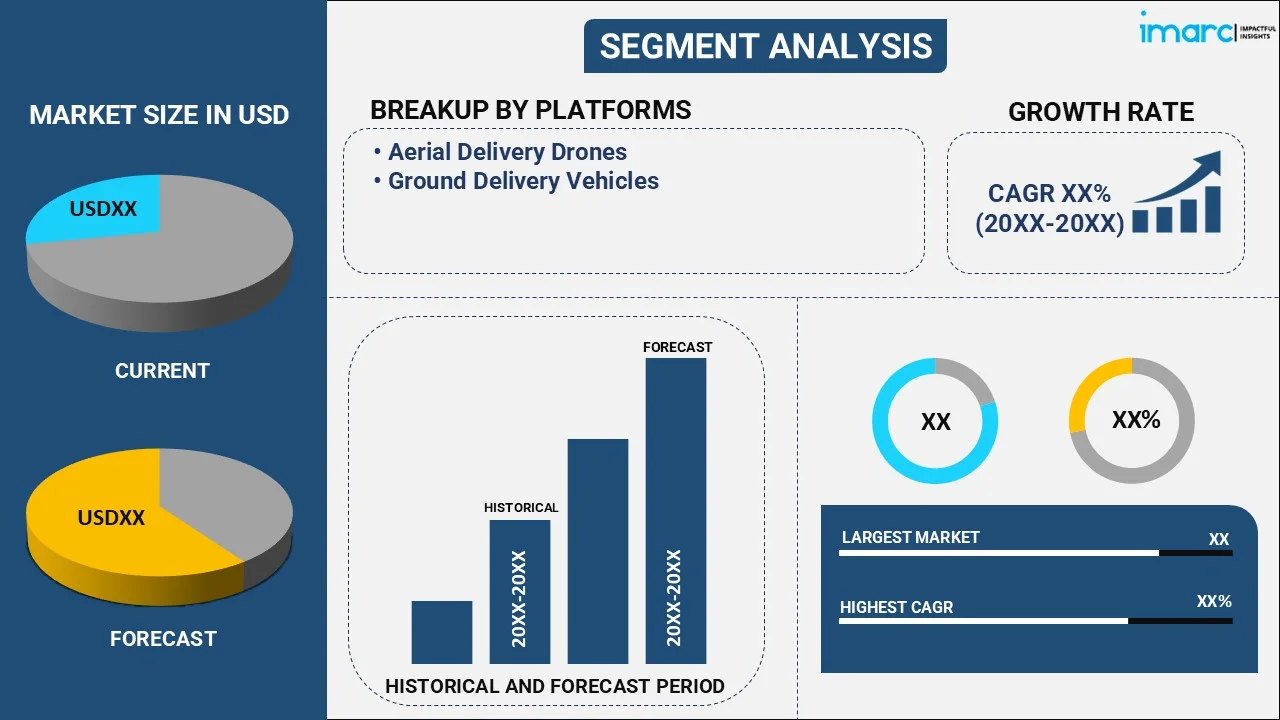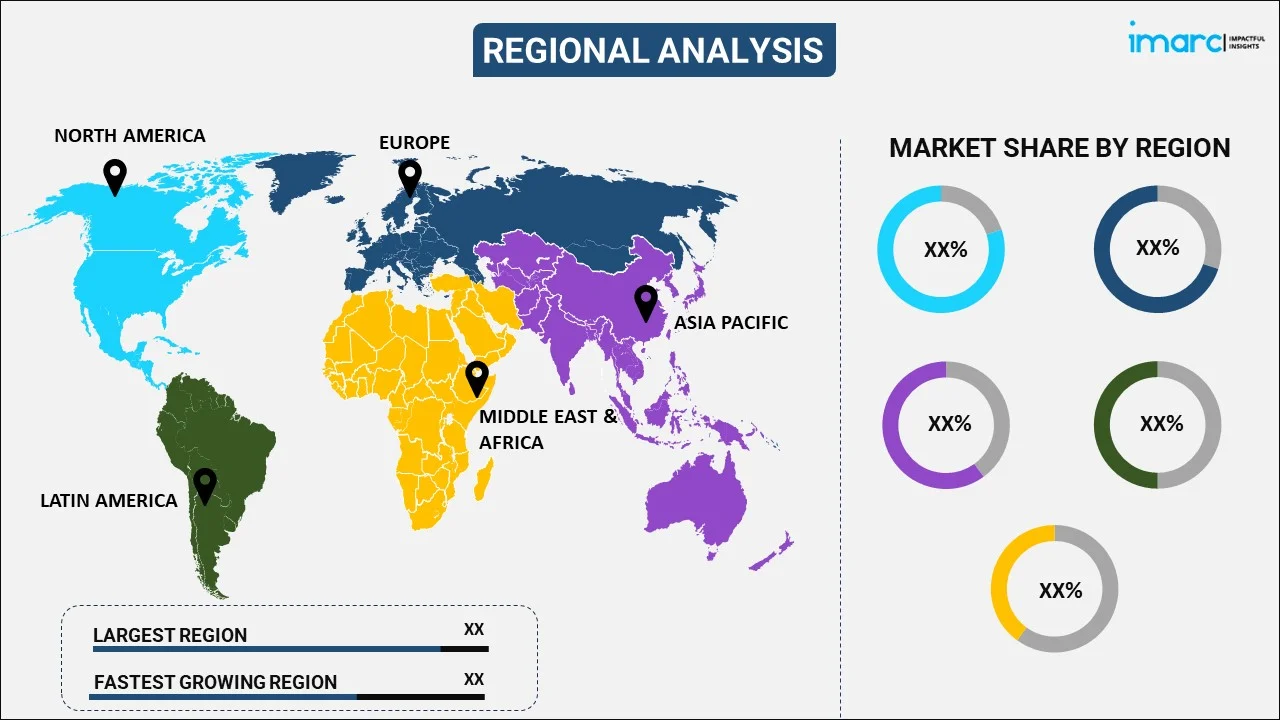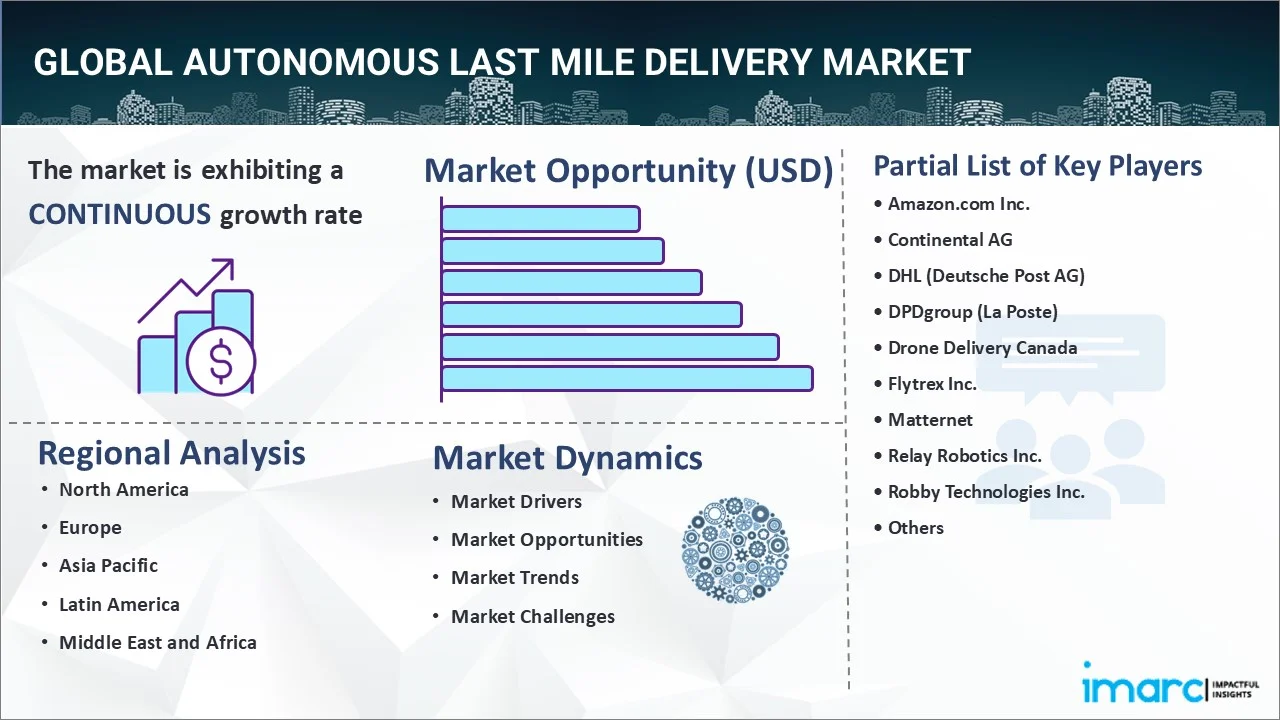
Autonomous Last Mile Delivery Market Report by Platform (Aerial Delivery Drones, Ground Delivery Vehicles), Solution (Hardware, Software, Services), Range (Short Range (< 20 Km), Long Range (> 20 Km)), Application (Logistics, Healthcare and Pharmaceutical, Food and Beverage, Retail, and Others), and Region 2025-2033
Global Autonomous Last Mile Delivery Market:
The global autonomous last mile delivery market size reached USD 21.9 Billion in 2024. Looking forward, IMARC Group expects the market to reach USD 96.8 Billion by 2033, exhibiting a growth rate (CAGR) of 17.95% during 2025-2033. The growing demand for effective delivery methods to ensure more rapid accessibility of products among consumers is stimulating the market.
|
Report Attribute
|
Key Statistics
|
|---|---|
|
Base Year
|
2024
|
|
Forecast Years
|
2025-2033
|
|
Historical Years
|
2019-2024
|
|
Market Size in 2024
|
USD 21.9 Billion |
|
Market Forecast in 2033
|
USD 96.8 Billion |
| Market Growth Rate (2025-2033) | 17.95% |
Autonomous Last Mile Delivery Market Analysis:
- Major Market Drivers: The inflating consumer requirement for quick package delivery and the changing dynamics of urban commercial deliveries are propelling the market.
- Key Market Trends: The extensive use of online shopping platforms for the delivery of basic necessities is one of the factors contributing to the autonomous last mile delivery market growth.
- Competitive Landscape: Some of the major market companies include Amazon.com Inc., Continental AG, DHL (Deutsche Post AG), DPDgroup (La Poste), Drone Delivery Canada, Flytrex Inc., Matternet, Relay Robotics Inc., Robby Technologies Inc., SkyDrop, ST Engineering Aethon Inc., Starship Technologies, and Udelv Inc., among many others.
- Geographical Trends: North America is currently dominating the market as a result of its robust e-commerce infrastructure, along with the rising customer need for speedier deliveries.
- Challenges and Opportunities: Navigating regulatory difficulties and safety concerns are among the challenges to the market. However, setting clearer rules and encouraging collaboration among business leaders and government entities to guarantee safe and efficient implementation will continue to catalyze the market over the forecast period.
Autonomous Last Mile Delivery Market Trends:
Rising Partnerships between Tech and Logistics Firms
Collaborations between technology firms and logistics providers are increasing. These alliances aim to expand autonomous delivery systems more effectively by merging knowledge in AI, robots, and logistics, thereby improving service speed and operational efficiency. In October 2024, Bolt collaborated with Starship Technologies to launch a new autonomous delivery food service. These companies aim to enhance the scalability and efficiency of services, combining Starship’s robotics technology with Bolt’s delivery network.
Expansion of Pilot Programs
Several companies are expanding pilot programs for autonomous delivery methods to assess their viability in real-world circumstances. Major retailers and logistics organizations are working with technology companies to see how these technologies may improve last-mile efficiency and shorten delivery times. In March 2024, Yango unveiled its autonomous last-mile solutions at the LEAP 2024 tech fair in Saudi Arabia. The company also introduced Yango Play and the human-like AI assistant Yasmina.
Increased Use of Drones
Drones are becoming increasingly popular for autonomous last-mile delivery, particularly in cities and distant places. Their ability to avoid traffic and reach difficult-to-reach areas makes them a game changer for quick and contactless delivery. In March 2024, DroneUp introduced the industry’s first drone autonomous ecosystem, integrating cutting-edge ground, air, and software products into a single platform.
Global Autonomous Last Mile Delivery Industry Segmentation:
IMARC Group provides an analysis of the key trends in each segment of the market, along with the market forecasts at the global, regional, and country levels for 2025-2033. Our report has categorized the market based on platform, solution, range, and application.
Breakup by Platform:

- Aerial Delivery Drones
- Cargo Drone
- Delivery Drone
- Ground Delivery Vehicles
- Delivery Robots
- Autonomous and Self-Driving Vans and Trucks
Currently, ground delivery vehicles hold the largest autonomous last mile delivery market share
The report has provided a detailed breakup and analysis of the market based on the platform. This includes aerial delivery drones (cargo drone and delivery drone) and ground delivery vehicles (delivery robots and autonomous and self-driving vans and trucks). According to the report, ground delivery vehicles represented the largest market segmentation.
Ground delivery vehicles are becoming increasingly popular due to their capacity to handle metropolitan environments, shorten delivery times, and reduce operational costs for logistics organizations.
Breakup by Solution:
- Hardware
- Software
- Services
Hardware holds the largest autonomous last mile delivery market size
The report has provided a detailed breakup and analysis of the market based on solution. This includes hardware, software, and services. According to the report, hardware represented the largest market segmentation.
Hardware solutions offer precise navigation, obstacle recognition, and safety, making them critical for the safe operation of autonomous delivery vehicles and drones.
Breakup by Range:
- Short Range (< 20 Km)
- Long Range (> 20 Km)
Among these, short range (< 20 km) holds the largest autonomous last mile delivery market share
The report has provided a detailed breakup and analysis of the market based on the range. This includes short range (< 20 km) and long range (> 20 km). According to the report, short range (< 20 km) represented the largest market segmentation.
Short range (<20 km) is suitable for urban locations, allowing for quick and cost-effective deliveries using autonomous ground vehicles and drones for e-commerce and local retail services.
Breakup by Application:
- Logistics
- Healthcare and Pharmaceutical
- Food and Beverage
- Retail
- Others
Currently, retail dominates the market with the largest autonomous last mile delivery market share
The report has provided a detailed breakup and analysis of the market based on the application. This includes logistics, healthcare and pharmaceutical, food and beverage, retail, and others. According to the report, retail represented the largest market segmentation.
In the retail industry, the market is changing the way goods are delivered, with retailers using self-driving cars and drones to provide faster and contactless deliveries. This technology improves client comfort while also allowing merchants to optimize logistics and minimize expenses.
Breakup by Region:

- North America
- United States
- Canada
- Asia-Pacific
- China
- Japan
- India
- South Korea
- Australia
- Indonesia
- Others
- Europe
- Germany
- France
- United Kingdom
- Italy
- Spain
- Russia
- Others
- Latin America
- Brazil
- Mexico
- Others
- Middle East and Africa
North America leads in the autonomous last mile delivery market growth
The report has also provided a comprehensive analysis of all the major regional markets, which include North America (the United States and Canada); Asia-Pacific (China, Japan, India, South Korea, Australia, Indonesia, and others); Europe (Germany, France, the United Kingdom, Italy, Spain, Russia, and others); Latin America (Brazil, Mexico, and others); and the Middle East and Africa. According to the report, North America accounted for the largest market share.
North America exhibits a clear dominance in the market driven by the rise in investments by major companies and startups in autonomous technology, which is stimulating innovation and enabling faster and more efficient autonomous deliveries in both urban and suburban settings.
Competitive Landscape:
The report has provided a comprehensive analysis of the competitive landscape. Detailed profiles of all major market companies have also been provided. Some of the key players in the market include:
- Amazon.com Inc.
- Continental AG
- DHL (Deutsche Post AG)
- DPDgroup (La Poste)
- Drone Delivery Canada
- Flytrex Inc.
- Matternet
- Relay Robotics Inc.
- Robby Technologies Inc.
- SkyDrop
- ST Engineering Aethon Inc.
- Starship Technologies
- Udelv Inc.
(Please note that this is only a partial list of the key players, and the complete list is provided in the report.)
Autonomous Last Mile Delivery Market Recent Developments:
- October 2024: Bolt collaborated with Starship Technologies to launch a new autonomous delivery food service. These companies aim to enhance the scalability and efficiency of services, combining Starship’s robotics technology with Bolt’s delivery network.
- March 2024: Yango unveiled its autonomous last-mile solutions at the LEAP 2024 tech fair in Saudi Arabia. The company also introduced Yango Play and the human-like AI assistant Yasmina.
- March 2024: DroneUp introduced the industry’s first drone autonomous ecosystem, integrating cutting-edge ground, air, and software products into a single platform.
Autonomous Last Mile Delivery Market Report Scope:
| Report Features | Details |
|---|---|
| Base Year of the Analysis | 2024 |
| Historical Period | 2019-2024 |
| Forecast Period | 2025-2033 |
| Units | Billion USD |
| Scope of the Report | Exploration of Historical Trends and Market Outlook, Industry Catalysts and Challenges, Segment-Wise Historical and Future Market Assessment:
|
| Platforms Covered |
|
| Solutions Covered | Hardware, Software, Services |
| Ranges Covered | Short Range (< 20 Km), Long Range (> 20 Km) |
| Applications Covered | Logistics, Healthcare and Pharmaceutical, Food and Beverage, Retail, Others |
| Regions Covered | Asia Pacific, Europe, North America, Latin America, Middle East and Africa |
| Countries Covered | United States, Canada, Germany, France, United Kingdom, Italy, Spain, Russia, China, Japan, India, South Korea, Australia, Indonesia, Brazil, Mexico |
| Companies Covered | Amazon.com Inc., Continental AG, DHL (Deutsche Post AG), DPDgroup (La Poste), Drone Delivery Canada, Flytrex Inc., Matternet, Relay Robotics Inc., Robby Technologies Inc., SkyDrop, ST Engineering Aethon Inc., Starship Technologies, Udelv Inc., etc. |
| Customization Scope | 10% Free Customization |
| Post-Sale Analyst Support | 10-12 Weeks |
| Delivery Format | PDF and Excel through Email (We can also provide the editable version of the report in PPT/Word format on special request) |
Key Benefits for Stakeholders:
- IMARC's industry report offers a comprehensive quantitative analysis of various market segments, historical and current market trends, market forecasts, and dynamics of the autonomous last mile delivery market from 2019-2033.
- The research report provides the latest information on the market drivers, challenges, and opportunities in the global autonomous last mile delivery market.
- The study maps the leading, as well as the fastest-growing, regional markets. It further enables stakeholders to identify the key country-level markets within each region.
- Porter's five forces analysis assists stakeholders in assessing the impact of new entrants, competitive rivalry, supplier power, buyer power, and the threat of substitution. It helps stakeholders to analyze the level of competition within the autonomous last mile delivery industry and its attractiveness.
- The competitive landscape allows stakeholders to understand their competitive environment and provides insight into the current positions of key players in the market.
Key Questions Answered in This Report
The global autonomous last mile delivery market was valued at USD 21.9 Billion in 2024.
We expect the global autonomous last mile delivery market to exhibit a CAGR of 17.95% during 2025-2033.
The rising integration of Artificial Intelligence (AI) and Machine Learning (ML) platforms with robots and drones to perform smart tracking, optimize the route, enable around clock delivery, etc., is primarily driving the global autonomous last mile delivery market.
The sudden outbreak of the COVID-19 pandemic has led to the growing deployment of last mile delivery solutions for purchasing daily necessities during the implementation of stringent lockdown regulations across several nations.
Based on the platform, the global autonomous last mile delivery market has been divided into aerial delivery drones and ground delivery vehicles. Currently, ground delivery vehicles exhibit a clear dominance in the market.
Based on the solution, the global autonomous last mile delivery market can be categorized into hardware, software, and services. Among these, hardware currently holds the majority of the total market share.
Based on the range, the global autonomous last mile delivery market has been segregated into short range (< 20 Km) and long range (> 20 Km). Currently, short range (< 20 Km) currently exhibits a clear dominance in the market.
Based on the application, the global autonomous last mile delivery market can be bifurcated into logistics, healthcare and pharmaceutical, food and beverage, retail, and others. Among these, the retail sector accounts for the largest market share.
On a regional level, the market has been classified into North America, Asia-Pacific, Europe, Latin America, and Middle East and Africa, where North America currently dominates the global market.
Some of the major players in the global autonomous last mile delivery market include Amazon.com Inc., Continental AG, DHL (Deutsche Post AG), DPDgroup (La Poste), Drone Delivery Canada, Flytrex Inc., Matternet, Relay Robotics Inc., Robby Technologies Inc., SkyDrop, ST Engineering Aethon Inc., Starship Technologies, and Udelv Inc.
Need more help?
- Speak to our experienced analysts for insights on the current market scenarios.
- Include additional segments and countries to customize the report as per your requirement.
- Gain an unparalleled competitive advantage in your domain by understanding how to utilize the report and positively impacting your operations and revenue.
- For further assistance, please connect with our analysts.

 Inquire Before Buying
Inquire Before Buying
 Speak to an Analyst
Speak to an Analyst
 Request Brochure
Request Brochure
 Request Customization
Request Customization




.webp)




.webp)












